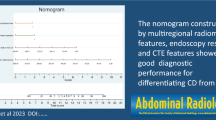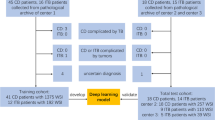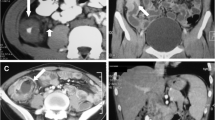Abstract
Objectives
Differentiating intestinal tuberculosis (ITB) from Crohn’s disease (CD) remains a diagnostic dilemma. Misdiagnosis carries potential grave implications. We aim to establish a multidisciplinary-based model using machine learning approach for distinguishing ITB from CD.
Methods
Eighty-two patients including 25 patients with ITB and 57 patients with CD were retrospectively recruited (54 in training cohort and 28 in testing cohort). The region of interest (ROI) for the lesion was delineated on magnetic resonance enterography (MRE) and colonoscopy images. Radiomic features were extracted by least absolute shrinkage and selection operator regression. Pathological feature was extracted automatically by deep-learning method. Clinical features were filtered by logistic regression analysis. Diagnostic performance was evaluated by receiver operating characteristic (ROC) curve and decision curve analysis (DCA). Delong’s test was applied to compare the efficiency between the multidisciplinary-based model and the other four single-disciplinary-based models.
Results
The radiomics model based on MRE features yielded an AUC of 0.87 (95% confidence interval [CI] 0.68–0.96) on the test data set, which was similar to the clinical model (AUC, 0.90 [95% CI 0.71–0.98]) and higher than the colonoscopy radiomics model (AUC, 0.68 [95% CI 0.48–0.84]) and pathology deep-learning model (AUC, 0.70 [95% CI 0.49–0.85]). Multidisciplinary model, integrating 3 clinical, 21 MRE radiomic, 5 colonoscopy radiomic, and 4 pathology deep-learning features, could significantly improve the diagnostic performance (AUC of 0.94, 95% CI 0.78–1.00) on the bases of single-disciplinary-based models. DCA confirmed the clinical utility.
Conclusions
Multidisciplinary-based model integrating clinical, MRE, colonoscopy, and pathology features was useful in distinguishing ITB from CD.
Graphical Abstract





Similar content being viewed by others
Abbreviations
- CD:
-
Crohn’s disease
- ITB:
-
Intestinal tuberculosis
- ATT:
-
Anti-tubercular therapy
- MRE:
-
Magnetic resonance enterography
- CTE:
-
Computed tomography enterography
- T1WIT1:
-
Weighted image
- T2WI:
-
T2 Weighted image
- DWI:
-
Diffusion weighted imaging
- ADC:
-
Apparent diffusion coefficient
- VOI:
-
Volume of interest
- ICC:
-
Intraclass correlation coefficient
- LASSO:
-
Least absolute shrinkage and selection operator
- RF:
-
Random forest
- ROI:
-
Region of interest
- CNN:
-
Convolutional neural network
- PCA:
-
Principal component analysis
- AUC:
-
Receiver operating characteristic curve
- CI:
-
Confidence interval
- DCA:
-
Decision curve analysis
- NRI:
-
Net reclassification improvement
- IDI:
-
Integrated discrimination improvement
References
Ng, S.C., H.Y. Shi, N. Hamidi, et al., Worldwide incidence and prevalence of inflammatory bowel disease in the 21st century: a systematic review of population-based studies. Lancet, 2017. 390(10114): p. 2769-2778.
Limsrivilai, J. and N. Pausawasdi, Intestinal tuberculosis or Crohn's disease: a review of the diagnostic models designed to differentiate between these two gastrointestinal diseases. Intest Res, 2021. 19(1): p. 21-32.
Kirsch, R., M. Pentecost, M. Hall Pde, et al., Role of colonoscopic biopsy in distinguishing between Crohn's disease and intestinal tuberculosis. J Clin Pathol, 2006. 59(8): p. 840–4.
Acharya, B., A. Acharya, S. Gautam, et al., Advances in diagnosis of Tuberculosis: an update into molecular diagnosis of Mycobacterium tuberculosis. Mol Biol Rep, 2020. 47(5): p. 4065-4075.
Maaser, C., A. Sturm, S.R. Vavricka, et al., ECCO-ESGAR Guideline for Diagnostic Assessment in IBD Part 1: Initial diagnosis, monitoring of known IBD, detection of complications. J Crohns Colitis, 2019. 13(2): p. 144-164.
Kedia, S., R. Sharma, S. Bopanna, G. Makharia, and V. Ahuja, Predictive Model for Differentiating Crohn's Disease and Intestinal Tuberculosis: The Story Is Incomplete Without Imaging. Am J Gastroenterol, 2017. 112(1): p. 188-189.
Yu, H., Y. Liu, Y. Wang, et al., Clinical, endoscopic and histological differentiations between Crohn's disease and intestinal tuberculosis. Digestion, 2012. 85(3): p. 202-9.
Zhu, C., Y. Yu, S. Wang, et al., A Novel Clinical Radiomics Nomogram to Identify Crohn's Disease from Intestinal Tuberculosis. J Inflamm Res, 2021. 14: p. 6511-6521.
Messaris, E., N. Chandolias, D. Grand, and V. Pricolo, Role of magnetic resonance enterography in the management of Crohn disease. Arch Surg, 2010. 145(5): p. 471-5.
He, Y., Z. Zhu, Y. Chen, et al., Development and Validation of a Novel Diagnostic Nomogram to Differentiate Between Intestinal Tuberculosis and Crohn's Disease: A 6-year Prospective Multicenter Study. Am J Gastroenterol, 2019. 114(3): p. 490-499.
Li, X.H., R. Mao, S.Y. Huang, et al., Characterization of Degree of Intestinal Fibrosis in Patients with Crohn Disease by Using Magnetization Transfer MR Imaging. Radiology, 2018. 287(2): p. 494-503.
Mao, R., W.D. Liao, Y. He, et al., Computed tomographic enterography adds value to colonoscopy in differentiating Crohn's disease from intestinal tuberculosis: a potential diagnostic algorithm. Endoscopy, 2015. 47(4): p. 322-9.
Zhao, X.S., Z.T. Wang, Z.Y. Wu, et al., Differentiation of Crohn's disease from intestinal tuberculosis by clinical and CT enterographic models. Inflamm Bowel Dis, 2014. 20(5): p. 916-25.
Koo, T.K. and M.Y. Li, A Guideline of Selecting and Reporting Intraclass Correlation Coefficients for Reliability Research. Journal of Chiropractic Medicine, 2016. 15(2): p. 155-163.
Tibshirani, R., Regression shrinkage and selection via the lasso: a retrospective. 2011. 73(3): p. 273-282.
Breiman, L., Random Forests. Machine Learning, 2001. 45(1): p. 5-32.
Lu, M.Y., D.F.K. Williamson, T.Y. Chen, et al., Data-efficient and weakly supervised computational pathology on whole-slide images. Nature Biomedical Engineering, 2021. 5(6): p. 555-570.
He, K., X. Zhang, S. Ren, and J. Sun. Deep Residual Learning for Image Recognition. in Proceedings of the IEEE Conference on Computer Vision and Pattern Recognition (CVPR). 2016.
Abdi, H. and L.J. Williams, Principal component analysis. 2010. 2(4): p. 433-459.
DeLong, E.R., D.M. DeLong, and D.L. Clarke-Pearson, Comparing the Areas under Two or More Correlated Receiver Operating Characteristic Curves: A Nonparametric Approach. Biometrics, 1988. 44(3): p. 837-845.
Pencina, M.J., R.B. D' Agostino Sr, R.B. D' Agostino Jr, and R.S. Vasan, Evaluating the added predictive ability of a new marker: From area under the ROC curve to reclassification and beyond. 2008. 27(2): p. 157–172.
Tabari, A., A. Kilcoyne, W.R. Jeck, M. Mino-Kenudson, and M.S. Gee, Texture Analysis of Magnetic Resonance Enterography Contrast Enhancement Can Detect Fibrosis in Crohn Disease Strictures. J Pediatr Gastroenterol Nutr, 2019. 69(5): p. 533-538.
Jung, Y., Y. Hwangbo, S.M. Yoon, et al., Predictive Factors for Differentiating Between Crohn's Disease and Intestinal Tuberculosis in Koreans. Am J Gastroenterol, 2016. 111(8): p. 1156-64.
Meng, Y., Y. Li, R. Hao, X. Li, and F. Lu, Analysis of Phenotypic Variables and Differentiation Between Untypical Crohn's Disease and Untypical Intestinal Tuberculosis. Dig Dis Sci, 2019. 64(7): p. 1967-1975.
Limsrivilai, J., A.B. Shreiner, A. Pongpaibul, et al., Meta-Analytic Bayesian Model For Differentiating Intestinal Tuberculosis from Crohn's Disease. Am J Gastroenterol, 2017. 112(3): p. 415-427.
Kim, J.M., J.G. Kang, S. Kim, and J.H. Cheon, Deep-learning system for real-time differentiation between Crohn's disease, intestinal Behçet's disease, and intestinal tuberculosis. J Gastroenterol Hepatol, 2021. 36(8): p. 2141-2148.
Epstein, D., G. Watermeyer, and R. Kirsch, Review article: the diagnosis and management of Crohn's disease in populations with high-risk rates for tuberculosis. Aliment Pharmacol Ther, 2007. 25(12): p. 1373-88.
Kedia S, Das P, Madhusudhan KS, et al. Differentiating Crohn's disease from intestinal tuberculosis. World J Gastroenterol. 2019. 28;25(4):418–432.
Funding
This study was supported by the National Natural Science Foundation of China [Grant Nos. 82070680, 82072002, 82270693, 82271958, 62371303].
Author information
Authors and Affiliations
Corresponding authors
Ethics declarations
Conflict of interest
All authors declare no competing interests.
Additional information
Publisher's Note
Springer Nature remains neutral with regard to jurisdictional claims in published maps and institutional affiliations.
Supplementary Information
Below is the link to the electronic supplementary material.
Rights and permissions
Springer Nature or its licensor (e.g. a society or other partner) holds exclusive rights to this article under a publishing agreement with the author(s) or other rightsholder(s); author self-archiving of the accepted manuscript version of this article is solely governed by the terms of such publishing agreement and applicable law.
About this article
Cite this article
Lu, B., Huang, Z., Lin, J. et al. A novel multidisciplinary machine learning approach based on clinical, imaging, colonoscopy, and pathology features for distinguishing intestinal tuberculosis from Crohn’s disease. Abdom Radiol (2024). https://doi.org/10.1007/s00261-024-04307-7
Received:
Revised:
Accepted:
Published:
DOI: https://doi.org/10.1007/s00261-024-04307-7




